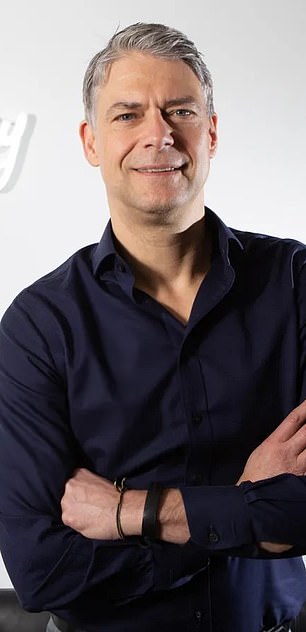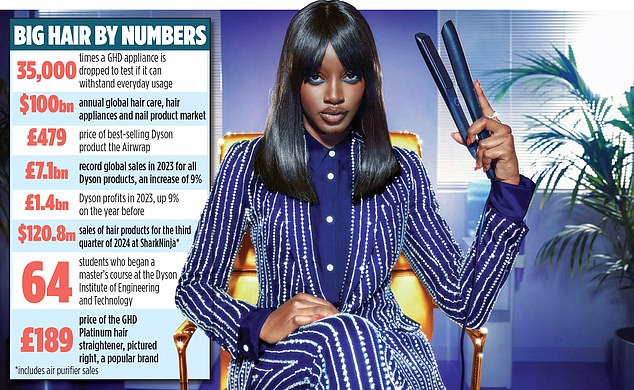Table of Contents
There’s a lot of hot air behind a growing area of the economy, and it’s a good thing. ‘Hair technology’ – devices that curl or straighten our hair – is something in which Britain leads the world and which promises export growth.
We may not give it much thought as we wield our curling irons and dryers, but hair technology involves the skill and innovation of thousands of specialized engineers, who have worked on devices that heat air to exact temperatures using artificial intelligence algorithms.
The rise of ‘hair tech’ is on display in the newly renovated beauty salon at John Lewis’ flagship store on Oxford Street, central London.
Each of the biggest players (GHD (which stands for good hair day), Dyson and SharkNinja) have their own boutique.
Women who want messy, ‘beachy’ waves or the bouncy dryers from the 1980s Disney+ drama series Rivals can compare competing products with their sleek aesthetics and microchip-controlled heating systems.
Learn how to wave a Platinum straightening wand, the best-performing product in GHD’s portfolio, and the enviable locks of Netflix’s Dallas Cowboys Cheerleaders can be yours. This series revived the ’80s saying, “the higher the hair, the closer to God,” an aphorism that would no doubt be endorsed by GHD director Jeroen Temmerman.
It says “demonstration and education” – in other words, teaching customers how to use the tools – are key to its sales, which reached $380m (£300m) worldwide in 2023.
Prices for the most popular hair technology items, ranging from £90 to around £500, may surprise.
Dyson’s Airstrait costs £450, while the new GHD Duet Blowdry costs £389.
But Temmerman, 53, defends the prices, saying: “It’s about design and not price.”
The global hair technology industry, worth about $10 billion a year, is part of the broader $100 billion market for hair care products, hair devices and nail products. But the hair technology industry is growing at a double-digit rate every year and the UK is leading the field.
The research behind a straightening iron or curling iron is not easy at all. Temmerman says it can take five to seven years for a new product to evolve. GHD’s research laboratory on the outskirts of Cambridge, which employs about 100 engineers, opened 21 years ago and now holds 117 patents.
Engineers work with materials scientists and physicists on all aspects of “thermal manipulation” (heat styling hair), such as removing “snags and drags.”
The company even says its stylists drop the hair the equivalent of 35,000 times to check they can handle the daily treatment.
GHD, founded in 2001, is also driven by the research and development of its parent, US hair care group Wella, majority owned by private equity giant KKR.

Chief boss: Jeroen Temmerman, head of GHD
Another American group, SharkNinja, which made its name with vacuum cleaners, launched its Shark Beauty tools in 2021, while Dyson diversified into hair technology in 2016. The British company invested £500 million in that business two years ago and is committed to launch 20 new hair products by 2026, following research into all aspects of hair, from “bark to cuticle.”
The company is cutting jobs in the UK but still employs thousands of engineers at its campuses in Malmesbury, Wiltshire. SharkNinja has a research and development center at its UK headquarters at Battersea Power Station, south west London.
Surprisingly, the United States (the country that has pioneered technology in all its forms, from laptops to phones, not to mention the world leader in long hair) is lagging behind when it comes to innovative hair styling products. Temmerman explains that American women go to hairdressers more readily than their British counterparts, who tend to do it more at home. Americans are also more cautious about wearing down their hair with clips or blow dryers that generate too much heat.
Now it aims to conquer the United States with its range of straighteners and curling irons that operate at a relatively modest temperature.
The rise of hair technology is based on the perception that expensive devices are not a luxury, but rather “an essential item,” as Temmerman puts it.
This was stated in the pandemic. In the early days of lockdown, for a moment it seemed like people wouldn’t care what their hair looked like while stuck at home.
“But then we all started talking to each other on Teams or Zoom,” Temmerman says, “and hair became really important.”
DIY INVESTMENT PLATFORMS

AJ Bell

AJ Bell
Easy investing and ready-to-use portfolios

Hargreaves Lansdown

Hargreaves Lansdown
Free Fund Trading and Investment Ideas

interactive inverter

interactive inverter
Fixed fee investing from £4.99 per month

sax

sax
Get £200 back in trading fees

Trade 212

Trade 212
Free trading and no account commission
Affiliate links: If you purchase a This is Money product you may earn a commission. These offers are chosen by our editorial team as we think they are worth highlighting. This does not affect our editorial independence.
Some links in this article may be affiliate links. If you click on them, we may earn a small commission. That helps us fund This Is Money and keep it free to use. We do not write articles to promote products. We do not allow any commercial relationship to affect our editorial independence.


